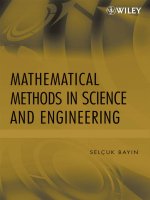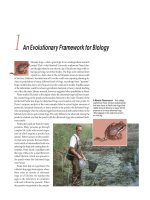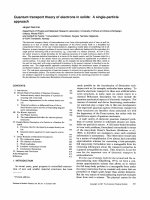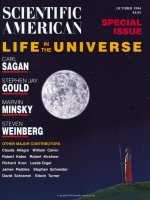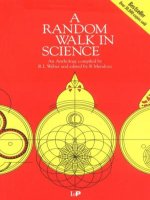- Trang chủ >>
- Khoa Học Tự Nhiên >>
- Vật lý
Quantum man; richard feynmans life in science
Bạn đang xem bản rút gọn của tài liệu. Xem và tải ngay bản đầy đủ của tài liệu tại đây (1.5 MB, 306 trang )
PUBLISHED TITLES IN THE GREAT DISCOVERIES SERIES
Sherwin B. Nuland
The Doctors’ Plague: Germs, Childbed Fever,
and the Strange Story of Ignác Semmelweis
Michio Kaku
Einstein’s Cosmos: How Albert Einstein’s Vision Transformed
Our Understanding of Space and Time
Barbara Goldsmith
Obsessive Genius: The Inner World of Marie Curie
Rebecca Goldstein
Incompleteness: The Proof and Paradox of Kurt Gödel
Madison Smartt Bell
Lavoisier in Year One: The Birth of a New Science
in an Age of Revolution
George Johnson
Miss Leavitt’s Stars: The Untold Story of the Woman
Who Discovered How to Measure the Universe
David Leavitt
The Man Who Knew Too Much: Alan Turing
and the Invention of the Computer
William T. Vollmann
Uncentering the Earth: Copernicus
and The Revolutions of the Heavenly Spheres
David Quammen
The Reluctant Mr. Darwin: An Intimate Portrait of Charles Darwin and the Making of His Theory
of Evolution
Richard Reeves
A Force of Nature: The Frontier Genius of Ernest Rutherford
Michael Lemonick
The Georgian Star: How William and Caroline Herschel
Revolutionized Our Understanding of the Cosmos
Dan Hofstadter
The Earth Moves: Galileo and the Roman Inquisition
www.pdfgrip.com
ALSO BY LAWRENCE M. KRAUSS
Hiding in the Mirror
Atom
Quintessence
Beyond Star Trek
The Physics of Star Trek
Fear of Physics
The Fifth Essence
www.pdfgrip.com
LAWRENCE M. KRAUSS
Quantum
Man
Richard Feynman’s Life in Science
with corrections by Cormac McCarthy
ATLAS & CO.
W. W. NORTON & COMPANY
NEW YORK • LONDON
www.pdfgrip.com
Reality must take precedence over public relations, for nature cannot be
fooled.
—RICHARD P. FEYNMAN, 1918–1988
www.pdfgrip.com
Contents
Introduction
PART I:
1:
CHAPTER 2:
CHAPTER 3:
CHAPTER 4:
CHAPTER 5:
CHAPTER 6:
CHAPTER 7:
CHAPTER 8:
CHAPTER 9:
CHAPTER 10:
CHAPTER
The Paths to Greatness
Lights, Camera, Action
The Quantum Universe
A New Way of Thinking
Alice in Quantumland
Endings and Beginnings
Loss of Innocence
Paths to Greatness
From Here to Infinity
Splitting an Atom
Through a Glass Darkly
PART II:
The Rest of the Universe
CHAPTER
11:
CHAPTER 12:
CHAPTER 13:
CHAPTER 14:
CHAPTER 15:
CHAPTER 16:
CHAPTER 17:
Matter of the Heart and the Heart of Matter
Rearranging the Universe
Hiding in the Mirror
Distractions and Delights
Twisting the Tail of the Cosmos
From Top to Bottom
Truth, Beauty, and Freedom
EPILOGUE:
Character Is Destiny
Acknowledgments and Sources
Index
www.pdfgrip.com
Introduction
I find physics is a wonderful subject. We know so very much and then
subsume it into so very few equations that we can say we know very little.
—RICHARD FEYNMAN, 1947
It
is often hard to disentangle reality from imagination when it
comes to childhood memories, but I have a distinct recollection of the
first time I thought that being a physicist might actually be exciting.
As a child I had been fascinated with science, but the science I had
studied was always removed from me by at least a half century, and
thus it hovered very close to history. The fact that not all of nature’s
mysteries had been solved was not yet firmly planted in my mind.
The epiphany occurred while I was attending a high school summer
program on science. I don’t know if I appeared bored or not, but my
teacher, following our regularly scheduled lesson, gave me a book
titled The Character of Physical Law by Richard Feynman and told me
to read the chapter on the distinction between past and future. It was
my first contact with the notion of entropy and disorder, and like
many people before me, including the great physicists Ludwig
Boltzmann and Paul Ehrenfest, who killed themselves after devoting
much of their careers to developing this subject, it left me befuddled
and frustrated. How the world changes as one goes from considering
simple problems involving two objects, like the earth and the moon,
to a system involving many particles, like the gas molecules in the
room in which I am typing this, is both subtle and profound—no doubt
too subtle and profound for me to appreciate at the time.
But then, the next day, my teacher asked me if I had ever heard of
antimatter, and he proceeded to tell me that this same guy Feynman
had recently won the Nobel Prize because he explained how an
antiparticle could be thought of as a particle going backward in time.
Now that really fascinated me, although I didn’t understand any of
www.pdfgrip.com
the details (and in retrospect I realize my teacher didn’t either). But
the notion that these kinds of discoveries were happening during my
lifetime inspired me to think that there was a lot left to explore.
(Actually while my conclusion was true, the information that led to it
wasn’t. Feynman had published his Nobel Prize–winning work on
quantum electrodynamics almost a decade before I was born, and
the ancillary idea that antiparticles could be thought of as particles
going backward in time wasn’t even his. Alas, by the time ideas filter
down to high school teachers and texts, the physics is usually twentyfive to thirty years old, and sometimes not quite right.)
As I went on to study physics, Feynman became for me, as he did
for an entire generation, a hero and a legend. I bought his Feynman
Lectures on Physics when I entered college, as did most other
aspiring young physicists, even though I never actually took a course
in which these books were used. But also like most of my peers, I
continued to turn to them long after I had moved on from the socalled introductory course in physics on which his books were based.
It was while reading these books that I discovered how my summer
experience was oddly reminiscent of a similar singular experience
that Feynman had had in high school. More about that later. For now
I will just say that I only wish the results in my case had been as
significant.
It was probably not until graduate school that I fully began to
understand the ramifications of what that science teacher had been
trying to relate to me, but my fascination with the world of
fundamental particles, and the world of this interesting guy Feynman,
who wrote about it, began that summer morning in high school and in
large part has never stopped. I just remembered, as I was writing
this, that I chose to write my senior thesis on path integrals, the
subject Feynman pioneered.
Through a simple twist of fate, I was fortunate enough to meet and
spend time with Richard Feynman while I was still an undergraduate.
At the time I was involved with an organization called the Canadian
www.pdfgrip.com
Undergraduate Physics Association, whose sole purpose was to
organize a nationwide conference during which distinguished
physicists gave lectures and undergraduates presented results from
their summer research projects. It was in 1974, I think, that Feynman
had been induced (or seduced, I don’t know and shouldn’t presume)
by the very attractive president of the organization to be the keynote
speaker at that year’s conference in Vancouver. At the meeting I had
the temerity to ask him a question after his lecture, and a
photographer from a national magazine took a picture of the moment
and used the photo, but more important, I had brought my girlfriend
along with me, and one thing led to another and Feynman spent
much of the weekend hanging out with the two of us in some local
bars.
Later, while I was at graduate school at MIT, I heard Feynman
lecture several times. Years later still, after I had received my PhD
and moved to Harvard, I presented a colloquium at Caltech, and
Feynman was in the audience, which was slightly unnerving. He
politely asked a question or two and then came up afterward to
continue the discussion. I expect he had no memory of our meeting in
Vancouver, and I am forever regretful of the fact that I never found
out, because while he waited patiently to talk to me, a persistent and
rather annoying young assistant professor monopolized the discussion
until Feynman finally walked off. I never saw him again, as he died a
few years later.
RICHA RD FEYNMAN WAS a legend for a whole generation of physicists long
before anyone in the public knew who he was. Getting a Nobel Prize
may have put him on the front page of newspapers around the world,
but the next day there are new headlines, and any popular name
recognition usually lasts about as long as the newspaper itself.
Feynman’s popular fame thus did not arise from his scientific
discoveries, but began through a series of books recounting his
personal reminiscences. Feynman the raconteur was every bit as
www.pdfgrip.com
creative and fascinating as Feynman the physicist. Anyone who came
into personal contact with him had to be struck immediately by his
wealth of charisma. His piercing eyes, impish smile, and New York
accent combined to produce the very antithesis of a stereotypical
scientist, and his personal fascination with such things as bongo
drums and strip bars only added to his mystique.
As often happens however, the real catalyst that made Feynman a
public figure arose by accident, in this case a tragic accident: the
explosion shortly after liftoff of the Challenger space shuttle, which
was carrying the first “civilian,” a public school teacher who was
scheduled to teach some classes from space. During the investigation
that ensued, Feynman was asked to join the NASA investigatory
panel, and in an uncharacteristic moment (he studiously avoided
committees and anything else that kept him away from his work), he
agreed.
Feynman pursued the task in his own, equally uncharacteristic way.
Rather than study reports and focus on bureaucratic proposals for the
future, Feynman talked directly to the engineers and scientists at
NASA, and in a famous moment during the televised hearings, he
performed an experiment, putting a small rubber O-ring in a glass of
ice water and thus demonstrating that the O-rings used to seal the
rocket could fail under temperatures as cold as those on the day of
the ill-fated launch.
Since that day, books chronicling his reminiscences, compilations of
his letters, audiotapes of “lost lectures,” and so on, have appeared,
and following his death, his legend has continued to grow. Popular
Feynman biographies have also been published, with the most
notable being James Gleick’s masterful Genius.
Feynman the human being will always remain fascinating, but when
I was approached about producing a short and accessible volume that
might reflect Feynman the man as seen through his scientific
contributions, I couldn’t resist. The exercise motivated me because I
would be reviewing all of his original papers. (Most people may not
www.pdfgrip.com
realize that it is rare for scientists to go back to the original literature
in their field, especially if the work is more than a generation old.
Scientific ideas get distilled and refined, and most modern
presentations of the same physics often bear very little resemblance
to the initial formulations.) But more important, I realized that
Feynman’s physics provides, in microcosm, a perspective on the key
developments in physics over the second half of the twentieth
century, and many of the puzzles he left unresolved remain with us
today.
In what follows I have tried to do justice to both the letter and the
spirit of Feynman’s work in a way in which he might have approved.
Perhaps for this reason this book is first and foremost about
Feynman’s impact on our current understanding of nature, as
reflected within the context of a personal scientific biography. I will
devote little space to the many arcane blind alleys and red herrings
that lure even the most successful scientists—and Feynman was no
exception—as they claw their way to scientific understanding. It is
hard enough, without having to sort through these false starts, for
nonexperts to gain a proper perspective of what physicists have
learned about the natural world. No matter how elegant or brilliant
some of the false starts may be, ultimately what matters are the
ideas that have survived by satisfying the test of experiment.
My modest goal therefore is to focus on Feynman’s scientific legacy
as it has affected the revolutionary discoveries of twentieth-century
physics, and as it may impact any unraveling of the mysteries of the
twenty-first century. The insight I really want to reveal to
nonphysicists, if I can, is why Feynman has reached the status of a
mythic hero to most physicists now alive on the planet. If I can
capture that, I will have helped readers understand something central
about modern physics and Feynman’s role in changing our picture of
the world. That, to me, is the best testimony I can give to the genius
that was Richard Feynman.
www.pdfgrip.com
PART I
The Paths to Greatness
Science is a way to teach how something gets to be known, what is not
known, to what extent things are known (for nothing is known absolutely),
how to handle doubt and uncertainty, what the rules of evidence are, how to
think about things so that judgments can be made, how to distinguish truth
from fraud, and from show.
—Richard Feynman
www.pdfgrip.com
CHAPTER
1
Lights, Camera, Action
Perhaps a thing is simple if you can describe it fully in several different ways
without immediately knowing that you are describing the same thing.
—RICHARD FEYNMAN
Could one have guessed while he was still a child that Richard
Feynman would become perhaps the greatest, and probably the most
beloved, physicist of the last half of the twentieth century? It is not so
clear, even if many of the incipient signs were there. He was
undeniably smart. He had a nurturing father who entertained him
with puzzles and instilled a love of learning, encouraging his innate
curiosity and feeding his mind whenever possible. And he had a
chemistry set and displayed a fascination with radios.
But these things were not that uncommon for bright youngsters at
the time. In most fundamental respects Richard Feynman appeared
to be a typical smart Jewish kid from Queens growing up after the
First World War, and it is perhaps that simple fact as much as
anything else that colored his future place in history. His mind was
extraordinary, yes, but he remained firmly grounded in reality, even
as he was driven to explore the most esoteric realms of our
existence. His disrespect for pomposity came from an early life in
which he was not exposed to it, and his disrespect for authority came
not only from a father who nurtured this independence but also from
an early life in which he was remarkably free to be a child, to follow
his own passions, and to make his own mistakes.
Perhaps the first signal of what was to come was Feynman’s literally
indefatigable ability to concentrate on a problem for hours at a time,
so much so that his parents began to worry. As a teenager, Feynman
made practical use of his fascination with radios: he opened a small
business fixing them. But unlike conventional repairmen, Feynman
www.pdfgrip.com
would delight in solving radio problems not merely by tinkering, but
by thinking.
And he would combine this remarkable ability to focus all of his
energy on a problem with an innate talent as a showman. His most
famous radio repair, for example, involved an episode where he
paced back and forth thinking while the broken radio shrieked in front
of its owner whenever it was first turned on. Finally young Feynman
pulled out two tubes and exchanged them, solving the problem. My
suspicion is that Feynman let the whole thing last longer than it
needed to, just for effect.
In later life almost exactly the same story would be told again. But
this one originated when a skeptical Feynman was asked to examine
a puzzling photograph from a bubble chamber—a device where
elementary particles would leave visible tracks. After thinking for a
while, he placed his pencil down on a precise spot in the picture and
claimed that there must be a bolt located right there, where a
particle had had an unanticipated collision, producing results that
otherwise had been misinterpreted. Needless to say, when the
experimenters involved in the claimed discovery went back to their
device and looked at it, there was the bolt.
The showmanship, while contributing to the Feynman lore, was not
important to his work however. Neither was his fascination with
women, which also emerged later. The ability to concentrate,
combined with an almost superhuman energy that he could apply to
a problem, was. But the final essential icing on the cake, when
combined with the former two characteristics, ultimately ensured his
greatness. It involved simply an almost unparalleled talent for
mathematics.
Feynman’s mathematical genius began to manifest itself by the time
he was in high school. While a sophomore he taught himself
trigonometry, advanced algebra, infinite series, analytical geometry,
and differential and integral calculus. And in his self-learning, the
other aspect of what made Feynman so unique began to materialize:
www.pdfgrip.com
he would recast all knowledge in his own way, often inventing a new
language or new formalism to reflect his own understanding. In
certain cases necessity was the mother of invention. When typing out
a manual on complex mathematics, in 1933, at the age of fifteen, he
devised “typewriter symbols” to reflect the appropriate mathematical
operations, since his typewriter did not have keys to represent them,
and created a new notation for a table of integrals that he had
developed.
Feynman entered MIT with the intent to study mathematics, but it
was a misplaced notion. Even though he loved mathematics, he
forever wanted to know what he could “do” with it. He asked the
chairman of the mathematics department this question and got two
different answers: “Insurance estimates,” and “If you have to ask
that, then you don’t belong in mathematics.” Neither resonated with
Feynman, who decided mathematics wasn’t for him, so he switched
to electrical engineering. Interestingly, this switch seemed too
extreme. If mathematics was without purpose, engineering was too
practical. Like the soup in the Goldilocks tale, however, physics was
“just right,” and by the end of his freshman year Feynman had
become a physics major.
The choice of course was an inspired one. Feynman’s innate talents
allowed him to excel in physics. But he had another talent that
mattered even more perhaps, and I don’t know if it was innate or not.
This was intuition.
Physical intuition is a fascinating, ephemeral kind of skill. How does
one know which avenue of approach will be most fruitful to solve a
physics problem? No doubt some aspects of intuition are acquired.
This is why physics majors are required to solve so many problems.
In this way, they begin to learn which approaches work and which
don’t, and increase their toolkit of techniques along the way. But
surely some aspect of physical intuition cannot be taught, one that
resonates at a certain place and time. Einstein had such intuition, and
it served him well for over twenty years, from his epochal work on
www.pdfgrip.com
special relativity to his crowning achievement, general relativity. But
his intuition began to fail him as he slowly drifted away from the
mainstream of interest in quantum mechanics in the twentieth
century.
Feynman’s intuition was unique in a different way. Whereas Einstein
developed completely new theories about nature, Feynman explored
existing ideas from a completely new and usually more fruitful
perspective. The only way he could really understand physical ideas
was to derive them using his own language. But because his
language was usually also self-taught, the end results sometimes
differed radically from what “conventional” wisdom produced. As we
shall see, Feynman created his own wisdom.
But Feynman’s intuition was also earned the hard way, based on
relentless labor. His systematic approach and the thoroughness with
which he examined problems were already evident in high school. He
recorded his progress in notebooks, with tables of sines and cosines
he had calculated himself, and later on in his comprehensive calculus
notebook, titled “The Calculus for the Practical Man,” with extensive
tables of integrals, which again he had worked out himself. In later
life he would amaze people by proposing a new way to solve a
problem, or by grasping immediately the heart of a complex issue.
More often than not this was because at some time, in the thousands
of pages of notes he kept as he worked to understand nature,
Feynman had thought about that very problem and explored not just
one, but a host of different ways of solving it. It was this willingness
to investigate a problem from every vantage point, and to carefully
organize his thinking until he had exhausted all possibilities—a
product of his deep intellect and his indefatigable ability to
concentrate—that set him apart.
Perhaps willingness is the wrong word here. Necessity would be a
better choice. Feynman needed to fully understand every problem he
encountered by starting from scratch, solving it in his own way and
often in several different ways. Later on, he would try to imbue this
www.pdfgrip.com
same ethic to his students, one of whom later said, “Feynman
stressed creativity—which to him meant working things out from the
beginning. He urged each of us to create his or her own universe of
ideas, so that our products, even if only answers to assigned
classwork problems, would have their own original character—just as
his own work carried the unique stamp of his personality.”
Not only was Feynman’s ability to concentrate for long periods
evident when he was young, but so was his ability to control and
organize his thoughts. I remember having a chemistry set when I was
a kid and I also remember often randomly throwing things together
to see what would happen. But Feynman, as he later emphasized,
“never played chaotically with scientific things.” Rather he always
carried out his scientific “play” in a controlled manner, always
attentive to what was going on. Again, much later, after his death, it
became clear from the extensive notes he took that he carefully
recorded each of his explorations. He even considered at one point
organizing his domestic life with his future wife along scientific lines,
before a friend convinced him that he was being hopelessly
unrealistic. Ultimately, his naivete in this regard disappeared, and
much later he advised a student, “You cannot develop a personality
with physics alone. The rest of life must be worked in.” In any case,
Feynman loved to play and joke, but when it came to science,
starting early on and continuing for the rest of his life, Feynman could
be deadly serious.
He may have waited until the end of his first year of university to
declare himself a physics major, but the stars aligned when he was
still in high school. In retrospect, what might have been the defining
moment occurred when his high school teacher, Mr. Bader, introduced
him to one of the most subtle and wonderful hidden mysteries of the
observable world, a fact that had built on a discovery made three
hundred years before he was born by a brilliant and reclusive lawyerturned-mathematician, Pierre de Fermat.
Like Feynman, Fermat would achieve public recognition late in life
www.pdfgrip.com
for something that was unrelated to his most substantial
accomplishments. In 1637, Fermat scrawled a brief note in the
margin of his copy of Arithmetica, the masterpiece by the famous
Greek mathematician Diophantus, indicating that he had discovered a
simple proof of a remarkable fact. The equation xn + yn = zn has no
integer solutions if n >2 (for n = 2, this is familiar as the Pythagorean
theorem relating lengths of the sides of a right triangle). It is doubtful
that Fermat really possessed such a proof, which 350 years later
required almost all of the developments of twentieth-century
mathematics and several hundred pages to complete. Nevertheless, if
Fermat is remembered at all today among the general public, it is not
for his many key contributions to geometry, calculus, and number
theory, but rather for this speculation in the margin that will forever
be known as Fermat’s last theorem.
Twenty-five years after making this dubious claim, Fermat did
present a complete proof of something else, however: a remarkable
and almost otherworldy principle that established an approach to
physical phenomena that Feynman would use later to change the
way we think about physics in the modern world. The issue to which
Fermat turned his attention in 1662 involved a phenomenon the
Dutch scientist Willebrord Snell had described forty years earlier.
Snell discovered a mathematical regularity in the way light is bent, or
refracted, when it crosses between two different media, such as air
and water. Today we call this Snell’s law, and it is often presented in
high school physics classes as yet one additional tedious fact to be
memorized, even though it played a profoundly important role in the
history of science.
Snell’s law pertains to the angles that a light ray makes when
transmitted across the surface between two media. The exact form of
the law is unimportant here; what is important is both its general
character and its physical origin. In simple terms, the law states that
when light goes from a less dense to a more dense medium, the
trajectory of the light ray is bent closer to the perpendicular to the
www.pdfgrip.com
surface between the media (see figure).
Snell’s law
Now, why does the light bend? Well, if light were made up of a
stream of particles, as Newton and others thought, one could
understand this relationship if the particles speed up as they move
from one medium to the other. They would literally be dragged
forward, moving more effectively in a direction perpendicular to the
surface they had just crossed. However, this explanation seemed
fishy even at the time. After all, in a more dense medium any such
particles would presumably encounter a greater resistance to their
motion, just as cars on a road end up moving more slowly in heavy
traffic.
There was another possibility, however, as the Dutch scientist
Christiaan Huygens demonstrated in 1690. If light were a wave and
not made of particles, then just as a sound wave bends inward when
it slows down, the same would occur for light if it too slowed down in
the denser medium. As anyone familiar with the history of physics
knows, light does indeed slow down in denser media, so that Snell’s
law provides important evidence that light behaves, in this instance,
like a wave.
Amost thirty years before Huygens’s work, Fermat too reasoned that
www.pdfgrip.com
light should travel more slowly in dense media than in less dense
media. Instead of thinking in terms of whether light was a wave or
particle, however, Fermat the mathematician showed that in this
case one could explain the trajectory of light in terms of a general
mathematical principle, which we now call Fermat’s principle of least
time. As he demonstrated, light would follow precisely the same
bending trajectory determined by Snell if “light travels between two
given points along the path of shortest time.”
Heuristically this can be understood as follows. If light travels more
quickly in the less dense medium, then to get from A to B (see figure)
in the shortest time, it would make sense to travel a longer distance
in this medium, and a shorter distance in the second medium in
which it travels more slowly. Now, it cannot travel for too long in the
first medium, otherwise the extra distance it travels would more than
overcome the gain obtained by traveling at a faster speed. One path
is just right, however, and this path turns out to involve a bending
trajectory that exactly reproduces the trajectory Snell observed.
Snell’s law
Fermat’s principle of least time is a mathematically elegant way of
determining the path light takes without recourse to any mechanistic
description in terms of waves or particles. The only problem is that
www.pdfgrip.com
when one thinks about the physical basis of this result, it seems to
suggest intentionality, so that, like a commuter in Monday-morning
rush-hour listening to the traffic report, light somehow considers all
possible paths before embarking on its voyage, and ultimately
chooses the one that will get it to its destination fastest.
But the fascinating thing is that we don’t need to ascribe any
intentionality to light’s wanderings. Fermat’s principle is a wonderful
example of an even more remarkable property of physics, a property
that is central to the amazing and a priori unexpected fact that
nature is comprehensible via mathematics. If there is any one
property that was a guiding light for Richard Feynman’s approach to
physics, and essential to almost all of his discoveries, it was this one,
which he thought was so important that he referred to it at least two
different times during his Nobel Prize address. First, he wrote,
It always seems odd to me that the fundamental laws of physics,
when discovered, can appear in so many different forms that are
not apparently identical at first, but, with a little mathematical
fiddling you can show the relationship. . . . it was something I
learned from experience. There is always another way to say the
same thing that doesn’t look at all like the way you said it before. .
. . I think it is somehow a representation of the simplicity of
nature. I don’t know what it means, that nature chooses these
curious forms, but maybe that is a way of defining simplicity.
Perhaps a thing is simple if you can describe it fully in several
different ways without immediately knowing that you are
describing the same thing.
And later (and more important for what was to come), he added,
Theories of the known, which are described by different physical
ideas, may be equivalent in all their predictions and are hence
www.pdfgrip.com
scientifically
indistinguishable.
However,
they
are
not
psychologically identical when trying to move from that base into
the unknown. For different views suggest different kinds of
modifications which might be made and hence are not equivalent
in the hypotheses one generates from them in one’s attempt to
understand what is not yet understood.
Fermat’s principle of least time clearly represents a striking example
of this strange redundancy of physical law that so fascinated
Feynman, and also of the differing “psychological utilities” of the
different prescriptions. Thinking about the bending of light in terms of
electric and magnetic forces at the interface between media reveals
something about the properties of the media. Thinking about it in
terms of the speed of light itself reveals something about light’s
intrinsic wavelike character. And thinking about it in terms of Fermat’s
principle may reveal nothing about specific forces or about the wave
nature of light, but it illuminates something deep about the nature of
motion. Happily, and importantly, all of these alternate descriptions
result in identical predictions.
Thus we can rest easy. Light does not know it is taking the shortest
path. It just acts like it does.
IT WASN’ T THE principle of least time, however, but an even subtler idea
that changed Feynman’s life that fateful day in high school. As
Feynman later described it, “When I was in high school, my physics
teacher—whose name was Mr. Bader—called me down one day after
physics class and said, ‘You look bored; I want to tell you something
interesting.’ Then he told me something that I found absolutely
fascinating, and have, since then, always found fascinating . . . the
principle of least action.” Least action may sound like an expression
that is more appropriate to describing the behavior of a customer
service representative at the phone company than a field like physics,
which is, after all, centered around describing actions. But the least
www.pdfgrip.com
action principle is very similar to Fermat’s principle of least time.
The principle of least time tells us that light always takes the path
of shortest time. But what about baseballs and cannonballs, planets,
and boomerangs? They don’t necessarily behave so simply. Is there
something other than time that is minimized whenever these objects
follow the paths prescribed by the forces acting on them?
Consider any object in motion, say, a falling weight. Such an object
is said to possess two different kinds of energy. One is kinetic energy,
and it is related to the motion of objects (and derives from the Greek
word for movement). The faster an object moves, the larger the
kinetic energy. The other part of an object’s energy is much subtler to
ascertain, as reflected in its name: potential energy. This kind of
energy may be hidden, but it is responsible for the ability of an object
to do work later on. For example, a heavy weight falling off the top of
a tall building will do more damage (and hence more work) smashing
the roof of a car, than will a similar weight dropped from several
inches above the car. Clearly the higher the object, the greater its
potential to do work, and hence the greater its potential energy.
Now, what the least action principle states is that the difference
between the kinetic energy of an object at any instant and its
potential energy at the same instant, when calculated at each point
along a path and then added up along the path, will be smaller for
the actual path the object takes than for any other possible
trajectory. An object somehow adjusts its motion so the kinetic
energy and the potential energy are as closely matched, on average,
as is possible.
If this seems mysterious and unintuitive, that is because it is
mysterious and unintuitive. How on earth would anyone ever come
up with this combination in the first place, much less apply it to the
motion of everyday objects?
For this we thank the Italian mathematician-physicist Joseph Louis
Lagrange, who is best known for his work on celestial mechanics. For
example, he determined the points in the solar system where the
www.pdfgrip.com
gravitational attraction from the different planets precisely cancels
the frame of reference of the orbiting body. They are called Lagrange
points. NASA now sends numerous satellites out to these points so
that they can remain in stable orbits and study the universe.
Lagrange’s greatest contribution to physics, however, may have
involved his reformulation of the laws of motion. Newton’s laws relate
the motion of objects to the net forces acting on them. However,
Lagrange managed to show that Newton’s laws of motion were
precisely reproduced if one used the “action,” which is the sum over a
path of the differences between kinetic and potential energy, now
appropriately called a Lagrangian, and then determined precisely
what sorts of motion would produce those paths that minimized this
quantity. The process of minimization, which required the use of
calculus (also invented by Newton), gave very different mathematical
descriptions of motion from Newton’s laws, but, in the spirit of
Feynman,
they
were
mathematically
identical,
even
if
“psychologically” very different.
IT WAS THIS strange principle of least action, often called Lagrange’s
principle, that Mr. Bader introduced the teenaged Feynman to. Most
teens would not have found it fascinating or even comprehensible,
but Feynman did, or so he remembered when he was older.
However, if the young Feynman had any inkling at the time that this
principle would return to completely color his own life story, he
certainly didn’t behave that way as he began to learn more about
physics once he entered MIT. Quite the contrary. His best friend as an
undergraduate at MIT, Ted Welton, with whom he worked through
much of undergraduate and even graduate physics, later described
Feynman’s “maddening refusal to concede that Lagrange might have
something useful to say about physics. The rest of us were
appropriately impressed with the compactness, elegance, and utility
of Lagrange’s formulation, but Dick stubbornly insisted that real
physics lay in identifying all the forces and properly resolving them
www.pdfgrip.com
into components.”
Nature, like life, takes all sorts of strange twists and turns, and most
important, it is largely insensitive to one’s likes and dislikes. As much
as Feynman tried early on to focus on understanding motion in a way
that meshed with his naive intuition, his own trajectory to greatness
involved a very different path. There was no unseen hand guiding
him. Instead, he forced his intuition to bend to the demands of the
problems of the time, rather than vice versa. The challenge required
endless hours and days and months of hard work training his mind to
wrap around a problem that the greatest minds in twentieth-century
physics had, up to that point, not been able to solve.
When he really needed it, Feynman would find himself returning
once again to the very principle that had turned him on to physics in
the first place.
www.pdfgrip.com



